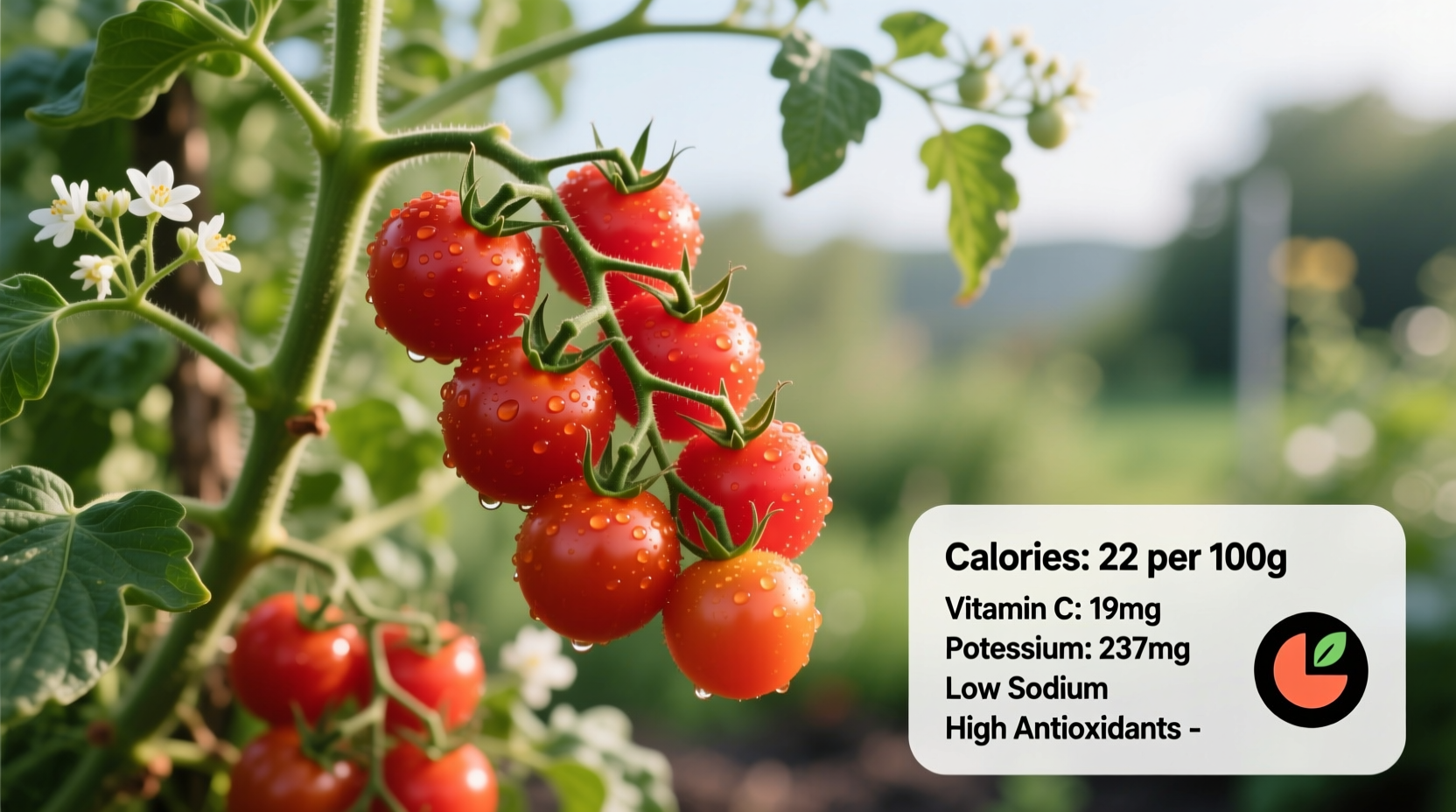Curious about how these tiny powerhouses fit into your daily nutrition goals? Let's explore exactly what makes cherry tomatoes such a smart addition to your diet while keeping your calorie count in check.
Understanding Cherry Tomato Calorie Content
When you're tracking your daily intake, knowing precise nutritional values matters. According to the USDA FoodData Central, the standard nutritional profile for raw cherry tomatoes is remarkably consistent:
| Measurement | Calories | Carbohydrates | Protein | Fat |
|---|---|---|---|---|
| One cherry tomato (17g) | 3 kcal | 0.7g | 0.2g | 0.05g |
| 100g serving | 18 kcal | 3.9g | 1.2g | 0.2g |
| Cup (149g) | 27 kcal | 5.8g | 1.8g | 0.3g |
This data represents the average values across multiple cherry tomato varieties. The slight variations you might encounter depend primarily on ripeness and specific cultivar, but the differences remain minimal for calorie-counting purposes.
How Cherry Tomatoes Compare to Other Tomato Varieties
Understanding where cherry tomatoes stand nutritionally compared to their larger cousins helps put their value in perspective. The following comparison reveals why many nutritionists recommend cherry tomatoes as a preferred snack option:
| Tomato Type | Calories per 100g | Water Content | Sweetness Level | Best Usage |
|---|---|---|---|---|
| Cherry tomatoes | 18 kcal | 94.9% | High | Snacking, salads, roasting |
| Grape tomatoes | 20 kcal | 94.5% | Very high | Snacking, cold dishes |
| Roma tomatoes | 22 kcal | 93.7% | Moderate | Cooking, sauces |
| Beefsteak tomatoes | 19 kcal | 94.4% | Low to moderate | Slicing, sandwiches |
As shown in this USDA-compliant comparison, cherry tomatoes actually contain slightly fewer calories than many larger tomato varieties while delivering higher natural sweetness. This makes them particularly valuable for those seeking satisfying, low-calorie snacks that don't compromise on flavor.
Why Calorie Count Isn't the Whole Story
While tracking calories matters for many dietary goals, cherry tomatoes offer nutritional benefits that extend far beyond their minimal caloric footprint. Each serving delivers:
- Vitamin C - One cup provides 22% of your daily requirement
- Vitamin A - Rich in beta-carotene for eye health
- Lycopene - Higher concentration than regular tomatoes due to their skin-to-flesh ratio
- Potassium - Essential for proper cellular function
- Dietary fiber - 1.2g per 100g, supporting digestive health
Research published in the Journal of Agricultural and Food Chemistry confirms that the smaller size of cherry tomatoes results in a higher skin-to-pulp ratio, which means greater concentrations of beneficial phytonutrients compared to larger tomato varieties.
Practical Applications for Your Diet
Knowing the exact calorie content helps you incorporate cherry tomatoes strategically into various eating plans. Here's how they perform in common dietary contexts:
Weight Management
With just 3 calories per piece, you can enjoy a substantial handful (15-20 tomatoes) for under 60 calories. This makes them an ideal snack when cravings strike between meals. Registered dietitians often recommend keeping a container of washed cherry tomatoes in the refrigerator for quick, satisfying bites that won't derail your calorie goals.
Keto and Low-Carb Diets
Cherry tomatoes contain approximately 3.9g of carbohydrates per 100g, with 2.0g coming from fiber. This net carb count of 1.9g per 100g makes them acceptable in moderation for most low-carb eating plans. Just be mindful of portion sizes when following strict keto protocols.
Diabetes Management
The American Diabetes Association recognizes cherry tomatoes as a non-starchy vegetable with a low glycemic index (approximately 15). Their fiber content helps moderate blood sugar response, making them a smart choice for those managing blood glucose levels.
Maximizing Nutritional Benefits
To get the most from your cherry tomatoes while maintaining their low-calorie advantage:
- Eat them whole - The skin contains concentrated nutrients, so avoid peeling
- Pair with healthy fats - Drizzle with olive oil to enhance absorption of fat-soluble vitamins
- Roast instead of boil - Preserves nutrients better than water-based cooking methods
- Store properly - Keep at room temperature away from direct sunlight to maintain flavor and nutrient profile
Contrary to popular belief, refrigeration actually degrades both the flavor and nutritional quality of tomatoes. The University of Minnesota Extension recommends storing tomatoes at 55-70°F (13-21°C) for optimal quality and nutrient retention.

Seasonal Availability and Selection Tips
Cherry tomatoes reach peak nutritional value during their natural growing season (late spring through early fall in most climates). When selecting them:
- Choose firm, plump tomatoes with smooth, unblemished skin
- Opt for deeper red varieties for higher lycopene content
- Avoid tomatoes with cracks or soft spots
- Smell the stem end - ripe cherry tomatoes should have a sweet, earthy aroma
During off-season months, vine-ripened greenhouse varieties typically offer better nutritional value than standard grocery store options. Frozen cherry tomatoes (flash-frozen at peak ripeness) can be a surprisingly good alternative when fresh options are limited.
Common Questions About Cherry Tomato Nutrition
Here are answers to frequently asked questions about cherry tomato calories and nutrition:











 浙公网安备
33010002000092号
浙公网安备
33010002000092号 浙B2-20120091-4
浙B2-20120091-4